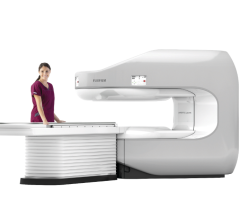
April 24, 2019 — Samsung announced that its new image post-processing engine (IPE), S-Vue 3.02, recently received U.S. Food and Drug Administration (FDA) clearance. The technology employs an advanced noise-reduction algorithm that allows devices to produce the same high-quality image using a fraction of the radiation in pediatric patients. Image evaluations on devices using S-Vue showed they reduced X-ray dose up to 45 percent for pediatric abdomen exams,* 15.5 percent for pediatric chest exams, and up to 27 percent for pediatric skull exams as compared with the previous IPE on the same X-ray systems.
Samsung’s digital radiography (DR) machines – including GC85A and GM85 – incorporate S-Vue 3.02, which provides spatially adaptive multi-scale processing and advanced de-noising technology, delivering quality images with a fraction of the dose.
“Findings of our clinical trial showed that use of Samsung’s S-Vue for pediatric chest images resulted in an overall image quality that was uncompromised even at a significantly reduced radiation exposure,” said Susan John, M.D., professor and chair, diagnostic and interventional imaging at McGovern Medical School at The University of Texas Health Science Center at Houston (UT Health). “The reduction in radiation dose potentially enables repeat radiographs for better follow-up in patients from infancy into adulthood, while assisting us in confident diagnosis.”
For more information: www.samsunghealthcare.com
*The claim concerning Samsung DR is based on limited phantom and clinical study results. Only routine PA chest radiography and abdominal radiography for average adults and pediatric abdominal, chest, skull radiography were studied, excluding pediatric patients under 1 month old.


 March 19, 2025
March 19, 2025 








